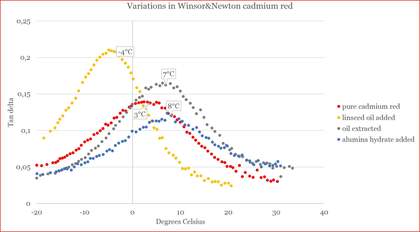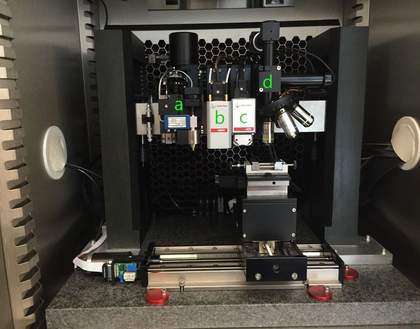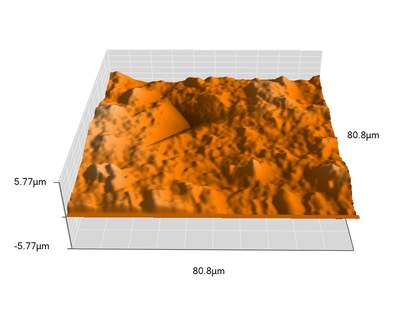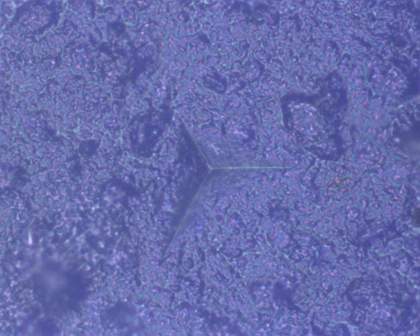Studies into the physical, mechanical properties of modern artists’ oil paints are being carried out as a collaboration between Centre for Art Technological Studies (CATS) in Copenhagen and the Getty Conservation Institute (GCI), Los Angeles.
In May 2017, CMOP researcher Cecil Krarup Andersen, assistant professor at The Royal Danish Academy of Fine Arts, Schools of Architecture, Design and Conservation, visited GCI for three weeks to partner with GCI scientists Alan Phenix, Michał Łukomski and Ashley Freeman (Fig. 1) on preliminary investigations into ways of characterizing the mechanical properties of modern oil paints in the set of samples under study by the CMOP group.
The mechanical properties – stiffness, flexibility, balance of elastic and plastic properties – are significant with regard to how the paint behaves in response to applied forces, such as the stresses induced by environmental conditions, and to conservation treatments. Two main instrumental methods were evaluated in this short study: Dynamic Mechanical Thermal analysis (DMA) and nanoindentation. The nanoindentation work was done on GCI’s recently acquired Anton Paar Ultra Nanoindentation tester (UNHT).

Fig. 1. The research team at the Getty Conservation Institute; from the left: Alan Phenix, Ashley Freeman, and Michał Łukomski. Photo: Foekje Boersma. © J. Paul Getty Trust 2017.
The paint samples we tested were from a group of proprietary artists’ oil paints, differently-pigmented and variously modified, that were prepared at the Courtauld Institute of Art in 2006. (Fig. 2)
The paints vary appreciably in their physical properties, ranging from soft and pliable to stiff and brittle. Slight modifications that had been made to the stock tube paints – addition or extraction of oil binder, addition of fatty acids or soaps – introduced subtle variations in physical properties that would challenge the instrumental test methods. The paint films being applied to, and inseparable from, polyester film provided an additional technical constraint for the mechanical testing: the test methods had to accommodate the fact of the paint being stuck on the polyester film.
What we suspect, too, is that there might be a difference in the properties of the surface of the paint, as opposed to the bulk. Furthermore, we hope to understand how different pigments and additives in modern oil paints influence the physical properties of the paints and what this means for their preservation; crucially, also, how they might react to cleaning treatments.

Fig. 2. One of the oil paint samples – Winsor & Newton cobalt blue – in the sample set made at the Courtauld Institute of Art in 2006, which are being tested by the CMOP group. The paints are cast on clear polyester film (Melinex). Photo: Mikkel Scharff, CATS/KADK.
Oil paints and primers have been tested extensively by conventional tensile testing in past research (Hagan et al 2007; Hagan 2017; Mecklenburg 1982; Mecklenburg et al 2005; Mecklenburg & Tumosa 1991; Young & Hagan 2008). Those studies provide basic information on deformation and ultimately failure in the paint samples. In a practical world of paintings conservation this translates into for example buckling and cracks in a painting.
With this research, we wanted to add to the previous knowledge by looking at the very surface of the paint samples. The surface is the part of the paint, which is more exposed to degradation from radiation, oxygen, air pollutants and shifts in relative humidity. The surface is also where dirt gets deposited and consequently the part of the painting that conservators clean.
The Dynamic Mechanical Analysis (DMA) testing followed a methodology developed by Phenix for testing paint films supported on polyester film (Phenix 2011). (Fig. 3) Although not suited to giving reliable, absolute measurements of paint elastic modulus (reflecting stiffness) it does provide good indications of the glass transition temperature (Tg) of the samples; that is, the temperature at which it changes from being stiff and glassy to being rubbery or leathery.
This information gives insight into how the material might respond to stress, for example at ambient temperature. The Dynamic Mechanical Analysis (DMA) measures simultaneously the variation in both the elastic (storage) modulus and the viscous (loss) modulus, as a function of temperature. The ratio of those properties (a value called tan δ) indicates the balance of elastic (solid) and viscous (liquid-like) behavior. The position of the peak maximum in the tan δ vs. temperature plot, obtained at an oscillating frequency of 1Hz, is commonly taken as the glass transition temperature (Tg) of the material under test. Some raw data from the DMA tests we did on Winsor & Newton cadmium red oil paints, both stock and modified, are shown in Fig. 4.

Fig. 3. Equipment for Dynamic Mechanical Analysis (DMA) of oil paint samples. Photo: Cecil Krarup Andersen, CATS/KADK.

Fig. 4. Tan δ vs. temperature plots for pure Winsor & Newton cadmium red paint, and the same paint modified with added components and oil extracted. Adding linseed oil lowers the Tg of the paint (i.e. makes it more rubbery-leathery), while extracting oil or adding alumina hydrate increases the Tg (i.e. makes it more glassy). These results show that the DMA method is capable of detecting the effects of minor variations in paint composition.
As already mentioned, conventionally, mechanical testing of artists’ materials has been performed using a Universal Testing Machine (UTM). This technique typically requires macro-sized samples that are placed under tension. Because of the required sample size and the fact that the samples are tensioned, generally, mock-ups which are prepared to mimic the composition and manufacturing process of historic materials are used for mechanical characterization. The use of micro- and nano-indentation provide us with the means to do mechanical analysis of smaller samples such as conservator prepared cross-sections from ‘real’ objects.
For this study, an Ultra Nanoindentation tester (UNHT) (Fig. 5) helped us to understand the influence that pigments and additives have on the stiffness of the paint strata. The indentation test was conducted by pressing a diamond tip stylus into the surface of the sample, at a certain rate and force, until a predetermined depth was reached. A really promising aspect of this technique is that it is virtually non-destructive, as it only leaves an imprint of a few microns in the surface of the test sample (Fig. 6).
From these tests, mechanical parameters such as stiffness were determined, where the higher the force needed the stiffer the paint sample. With these analyses we try to come closer to an understanding of the many factors that might influence the vulnerability of modern oil paints to cleaning action.

Fig. 5. Interior of the indentation apparatus at the GCI, modules from left to right: (a) Micro Combi Tester (MCT), (b) Ultra Nanoindentation Tester (UNHT), (c) Atomic Force Microscope (AFM), and (d) optical video microscope (5x, 20x, 50x, 100x) (Anton Paar). The different testers and microscopes are “positionally synchronized”, allowing for the area of interest to be located automatically when switching between the different modules. Photo:Evan Guston. © J. Paul Getty Trust 2017.
When carrying out indentation tests, a number of different sample properties need to be taken into consideration, including, but not limited to, surface roughness, thickness, and hardness. Preliminary indentation tests were carried out on a number of different paint samples to determine appropriate indentation test parameters.


Fig. 6a. and Fig. 6b. One of the residual indents as a results of preliminary tests on the Winsor & Newton cobalt blue sample. The top image is a 3D rendering of Atomic Force Microscopy (AFM) scan (scan range 80.8 x 80.8 µm) and the bottom image is optical microscope image (50X).
In the future, the two institutions will continue the collaboration and explore especially the nanoindentation technique further. With indentation, we hope to obtain results on the mechanical properties of modern oil paint surfaces in different ambient environments as well as before and after cleaning.
Furthermore, the water vapor sorption of the same oil paints will be tested with dynamic vapor sorption (DVS), and the results will be compared to the sensitivity of the samples to cleaning with water, tested at the Courtauld Institute of Art, also a partner within the CMOP collaboration (Mills et al., 2008). DVS will also help us determine the response time we can expect when paints are moved to different climatic conditions.
With all these results, we expect to contribute to the understanding of the sensitivity of oil paints to cleaning as well as the impact of exposure to changing relative humidity and temperature.
Cecil Krarup Andersen (Centre for Art Technological Studies, Copenhagen, Denmark), Ashley Freeman, Michał Łukomski and Alan Phenix (Getty Conservation Institute, Los Angeles, USA)
October 2017
References
HAGAN, E., CHARALAMBIDES, M., LEARNER, T.J., MURRAY, A. & YOUNG, C. 2007. ‘Factors Affecting the Mechanical Properties.’ In Modern Paints Uncovered. Los Angeles: Getty Publications. 227.
HAGAN, E.W. 2017. ‘Thermo-mechanical properties of white oil and acrylic artist paints.’ Progress in Organic Coatings, 104, 28-33.
MECKLENBURG, M.F. 1982. ‘Some aspects of the mechanical behavior of fabric-supported paintings.’ Smithsonian Year: annual report of the Smithsonian Institution. Smithsonian Institution, Conservation Research Laboratory. Unpublished.
MECKLENBURG, M.F.& TUMOSA, C.S. 1991. ‘Mechanical behavior of paintings subjected to changes in temperature and relative humidity.‘ In Art in Transit: Studies in the Transport of Paintings. MECKLENBURG, M., ed. Washington DC: National Gallery of Art. 173-216.
MECKLENBURG, M.F., TUMOSA, C.S.& ERHARDT, D. 2005 ‘The changing mechanical properties of aging oil paints’. In: eds. Materials issues in art and archaeology VII: proceedings of symposium held November 30-December 3, 2004, Boston, MA. VANDIVER, P.B., MASS, J.L.& MURRAY, A., eds. Warrendale, PA: Materials Research Society. 13-24.
MILLS, L., BURNSTOCK, A., DE GROOT, S., MEGENS, L., BISSCHOFF, M., VAN KEULEN, H., DUARTE, F. & VAN DEN BERG, K. 2008. ‘Water sensitivity of modern artists’ oil paints’. Preprints of 15th Triennial Conference, ICOM Committee for Conservation, New Delhi. 651-659.
PHENIX, A. 2011. ‘Thermal mechanical transitions in artists’ oil paints and selected conservation materials: a study by Dynamic Mechanical Analysis (DMA).’ Postprints of the Paintings Speciality Group meeting, American Institute for Conservation conference 2009, Los Angeles. Buckley, B., ed. Washington DC: American Institute for Conservation. 72-89.
YOUNG, C. & HAGAN, E. 2008. ‘Cold temperatures effect on modern paints used for priming flexible supports.’ In Preparation for Painting: The artists’ choice and its consequences. TOWNSEND, J.H.E.A., ed. London: Archetype Pubs. 163-71.
